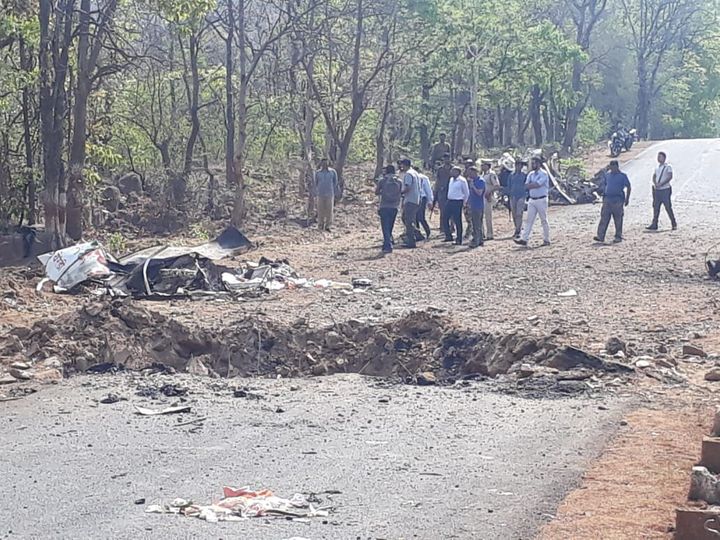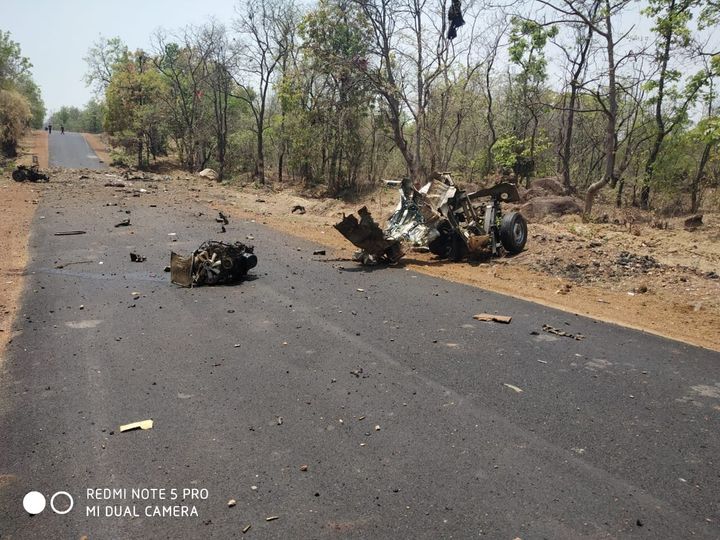
JAIPUR/NEW DELHI — The Maharashtra police did not follow standard operating procedures resulting in security lapses that led to the death of 15 policemen and a driver in a Maoist-triggered IED explosion in Gadchiroli on May 1, HuffPost India has learnt.
Details emerging from the blast site also indicate that the guerillas are far from a spent force, and retain the ability to plan in advance and launch lethal attacks on security forces.
In interviews, a senior police officer with direct knowledge of troop movements said that the police did not deploy a security cordon — known as a Road Opening Party, or ROP — to secure the road on which the Improvised Explosive Device (IED) was triggered. The policemen were traveling in an unarmoured vehicle which offered no protection from ambush, rather than in a mine-proof vehicle.
The police officer admitted that the police force may have been lulled into complacency after ensuring that the Lok Sabha elections in the region were conducted without incident.
“The ROP was not there. But we can not call it a lapse,” the police officer said. “It is not possible to go everywhere in the district by taking the ROP.”
“It was a tar road so we normally go by vehicles there. In fact, nothing was happening in that area for a long time,” the officer continued. “This area doesn’t have a history of being a sensitive area or a known spot of Maoist activities for a long time now.”
However, a senior explosives expert with years of experience in the red corridor contested this approach. Standard operating procedures, he said existed for a reason — because they save lives.
Maoist Trap
A review of the events leading up to the incident suggests that the police walked into a classic trap that the Maoists have used on several occasions in their decades-long war with the Indian state.
The night before the blast, on April 30, the Maoists torched 36 vehicles in Dadapur village, a settlement about 15 kilometers away from the spot of this blast.
The torching of the vehicles, it now emerges, was probably part of a plan to goad the police into action and then strike at an opportune moment.
The following morning on May 1, Inspector General of Maharashtra Police (Gadchiroli Range) Sharad Shelar told HuffPost India, a Quick Reaction Team (QRT) was deployed in the area on an anti-Maoist operation, only to be caught in the blast.
Publicly the Maharashtra police have put on a brave face.
Deputy Inspector General of Police (Gadchiroli range) Ankush Shinde disputed the suggestion that the Maoists had burnt vehicles the night before to lure the QRT into a trap.
When asked if the QRT was rushing to the arson spot when they were attacked, Shinde told the Indian Express, “We don’t rush to such spots since it is always fraught with the danger of ambush. I will have to get the ground report about where the QRT was headed.”

Buried IED
The location of the blast site has caught policemen by surprise. While Gadchiroli’s southern parts are considered particularly sensitive as they share a border with Chhattisgarh; this particular blast occurred in the north. The north is not as thickly forested or as hilly as the south.
“South Gadchiroli is always considered more sensitive than the north. It’s true we thought that north Gadchiroli became normal area since there was no major violent incident for so many years,” the police source said. “Even the election happened very peacefully with a high turnout. But it is a conflict zone and you can’t follow every rule in the SOP there.”
The nature of the IED has also rung alarm bells within the security establishment. The road in Gadchiroli is a black-top road that is level with its surroundings, unlike in neighboring Chhattisgarh where many interior roads are built on raised embankments.
In Chhattisgarh, the Maoists lay IEDs by burrowing into the embankments on which the roads are built. Here, the Maoists would have placed the IED by first digging vertical two to three-foot dee shaft beside the road, and then burrowing horizontally under the road surface to place the bomb, according to a source with direct knowledge of Maoist-built IEDs. The shaft would then have been filled with earth.
“The shelf-life of commercial explosives is 4 months at the most,” said the source, who has not visited the bomb site. “I’d estimate that this IED was probably placed 10 days ago, and the Maoists then burnt the vehicles and waited for the police response.”
Digging a shaft like this would have taken several hours, possibly spread out over more than one day, the source said. This suggests that the Maharashtra police’s informer network is not as strong as assumed.
“It is possible that after their success in killing 52 Maoists last year, the Maharashtra police had become complacent,” the source said.
Maharashtra police officers said the explosion could have been motivated by a need to respond to these killings. IPS officer informed that the Maoists were desperate to make their presence felt in the district after 40 of them were killed in two incidents within 48 hours in the district last year.
“They don’t keep silent for so long but they take their time,” the policeman said. “They wanted to show their presence in the district.”

Soon after the incident, NCP chief Sharad Pawar demanded that Maharashtra chief minister Devendra Fadnavis, who also holds the Home portfolio in the state, tender his resignation immediately.
Maharashtra finance minister Sudhir Manguntiwar, while speaking to a news channel on Monday, had admitted that there might have been a lapse on the part of the administration in this incident.
The Congress also termed this incident as a lapse on the part of Fadnavis.
“It is a lapse on the part of the Chief Minister as a home minister. It was the foundation day of the state yesterday and no precautionary measure was taken despite continuous threats issued by the Maoists,” Congress spokesperson Atul Londhe demanded. “It was an intelligence failure and a security lapse. The CM must resign.”
When asked if Maharashtra needed a full-time home minister, Londhe said, “It’s not about having a full-time home minister. It’s a matter of efficiency. This chief minister has proved to be an inefficient one time and again. He has failed to maintain law and order in his own hometown and the state.
“It’s sad that these people’s lapse has caused a loss of 15 lives,” Londhe concluded.
BJP Maharashtra spokesperson Madhav Bhandari did not respond to call from HuffPost India.